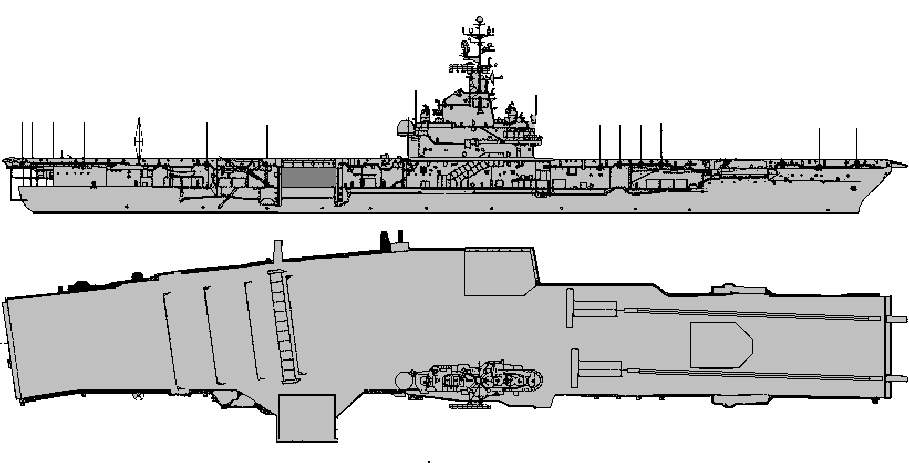
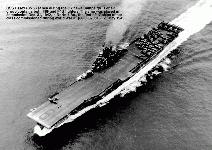
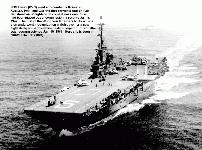
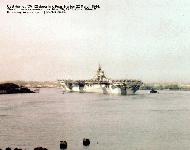
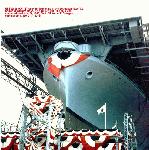
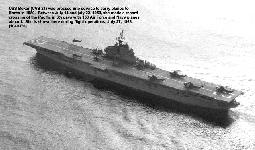
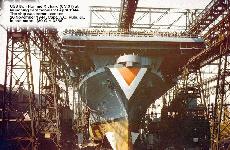
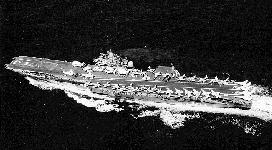
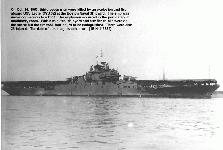
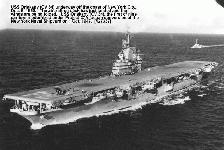
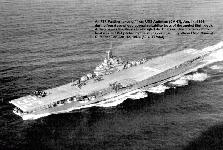
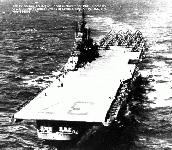
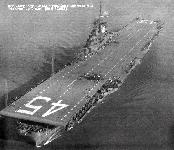
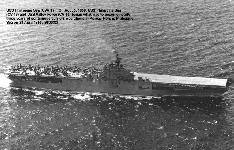
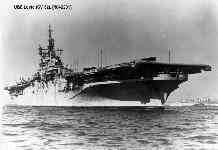



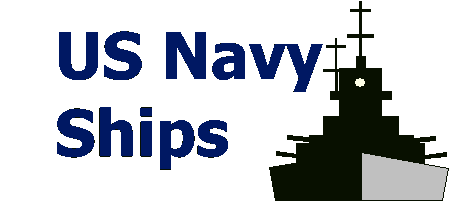
The USS Essex (CV 9) was placed out of commission in reserve on 09 January 1947. The first of the World War II carriers to do so, she then underwent modernization which gave her a new flight deck, and a streamlined island superstructure. On 04 June 1947 the CNO approved Project 27A by which Essex-class carriers were modernized to be able to handle aircraft to 40,000 pounds and included the installation of two H-8 catapults, strengthening the flight deck and clearing it of guns, increasing elevator capacity and adding special provisions for jet aircraft such as blast deflectors. USS Oriskany (CV 34), the first of nine carriers modernized under this project, began conversion at the New York Naval Shipyard on 01 October 1947. USS Essex (CV 9) was recommissioned 16 January 1951, and on 23 August 1951 she went into combat in Korea, the first carrier to launch F2H Banshee twinjet fighters on combat missions.
On 01 February 1952 the CNO approved Project 27C, a modification of Project 27A. These changes included more powerful arresting gear, higher performance catapults, and a replacement of the number three centerline elevator with a deck-edge type of greater capacity. Three Essex-class carriers incorporating these modifications were completed under Project 27C.
On 12 January 1953 test operations begin on USS Antietam (CVA 36), which emerged in December 1952 from the New York Naval Shipyard as America's first angled-deck aircraft carrier.
The Lexington was commissioned on February 17, 1943, and was responsible for destroying over 1 million tons of shipping and more than 1,000 enemy planes during World War II. Tokyo Rose called the Lady Lex the `Blue Ghost' because of numerous reports of her sinking only to return to battle painted a blue-grey color which was different from the camouflage coloring of other naval vessels. After the Lex's brilliant stint during World War II, she was involved with the 7th Fleet off of Taiwan in 1958, and was on standby for the Laotian crisis of 1959, and served as an attack carrier during the Cuban missile crisis in 1963.
After the Cuban missile crisis, she sailed back to Pensacola to serve as an aviation training carrier. She was homeported in Pensacola since 1962 , where it served as the Navy's only aircraft carrier used exclusively for training. This important new role allowed her to train new student aviators and maintain the high state of flight training for active duty and reserve naval forces. In fact, her decks trained the Navy and Marine pilots who fought to preserve the peace in conflicts from the Vietnam war to the Persian Gulf war.
The training aircraft carrier USS LEXINGTON (AVT 16) operated out of Pensacola, providing deck-landing and takeoff experience for Naval aviation cadets for over 20 years prior to being decommissioned on 08 November 1991. When the Navy announced the decommissioning and retirement of the Lexington in 1991, several communities launched efforts to have the ship transferred to their respective areas for use as a naval museum and memorial. On February 18, 1992, the Secretary of the Navy notified the Congress of his intent to transfer the obsolete aircraft carrier Lexington to the Corpus Christi Area Convention and Visitors Bureau.
Specifications | |
| Displacement | 27,100 tons 41,200 tons fully loaded as modified |
| Length | 872 feet 910 feet as modified |
| Beam | 147' 6" |
| Draft | 28' 7" |
| Speed | 33 knots |
| Crew | 2,631-3,448 |
Ships | |||||||
| Number | Name | Builder | Homeport | Laid Down | Launched | Commissioned | Decommissioned |
| CV 9 | Essex | 1941 | 1942 | 1942 | 1947 | ||
| CV 10 | Yorktown | 1941 | 1943 | 1943 | 1947 | ||
| CV 11 | Intrepid | 1941 | 1943 | 1943 | 1947 | ||
| CV 12 | Hornet | 1942 | 1943 | 1943 | 1947 | ||
| CV 13 | Franklin | 1942 | 1943 | 1944 | 1947 | ||
| CV 14 | Ticonderoga | 1943 | 1944 | 1944 | 1947 | ||
| CV 15 | Randolph | 1943 | 1944 | 1944 | 1948 | ||
| CV 16 | Lexington | 1941 | 1942 | 1943 | 08 Nov 1991 | ||
| CV 17 | Bunker Hill | 1941 | 1942 | 1943 | 1947 | ||
| CV 18 | Wasp | 1942 | 1943 | 1943 | 1947 | ||
| CV 19 | Hancock | 1943 | 1943 | 1944 | 1947 | ||
| CV 20 | Bennington | 1942 | 1944 | 1944 | 1946 | ||
| CV 21 | Boxer | 1943 | 1944 | 1945 | 1959 | ||
| CV 31 | Bon Homme Richard | 1943 | 1944 | 1944 | 1947 | ||
| CV 32 | Leyte | 1944 | 1945 | 1946 | 1959 | ||
| CV 33 | Kearsage | 1944 | 1945 | 1946 | 1950 | ||
| CV 34 | Oriskany | 1944 | 1945 | 1950 | 1976 | ||
| CV 35 | Reprisal | 1944 | - | - | 1945 | ||
| CV 36 | Antietam | 1943 | 1944 | 1945 | 1963 | ||
| CV 37 | Princeton | 1943 | 1945 | 1945 | 1949 | ||
| CV 38 | Shangri-La | 1943 | 1944 | 1944 | 1947 | ||
| CV 39 | Lake Champlain | 1943 | 1944 | 1945 | 1947 | ||
| CV 40 | Tarawa | 1944 | 1945 | 1945 | 1949 | ||
| CV 45 | Valley Forge | 1944 | 1945 | 1946 | 1961 | ||
| CV 46 | Iwo Jima | 1945 | - | - | 1945 | ||
| CV 47 | Phillipine Sea | 1944 | 1945 | 1946 | 1969 | ||
| CV 50 | - | - | - | - | 1945 | ||
| CV 51 | - | - | - | - | 1945 | ||
| CV 52 | - | - | - | - | 1945 | ||
| CV 53 | - | - | - | - | 1945 | ||
| CV 54 | - | - | - | - | 1945 | ||
| CV 55 | - | - | - | - | 1945 | ||














